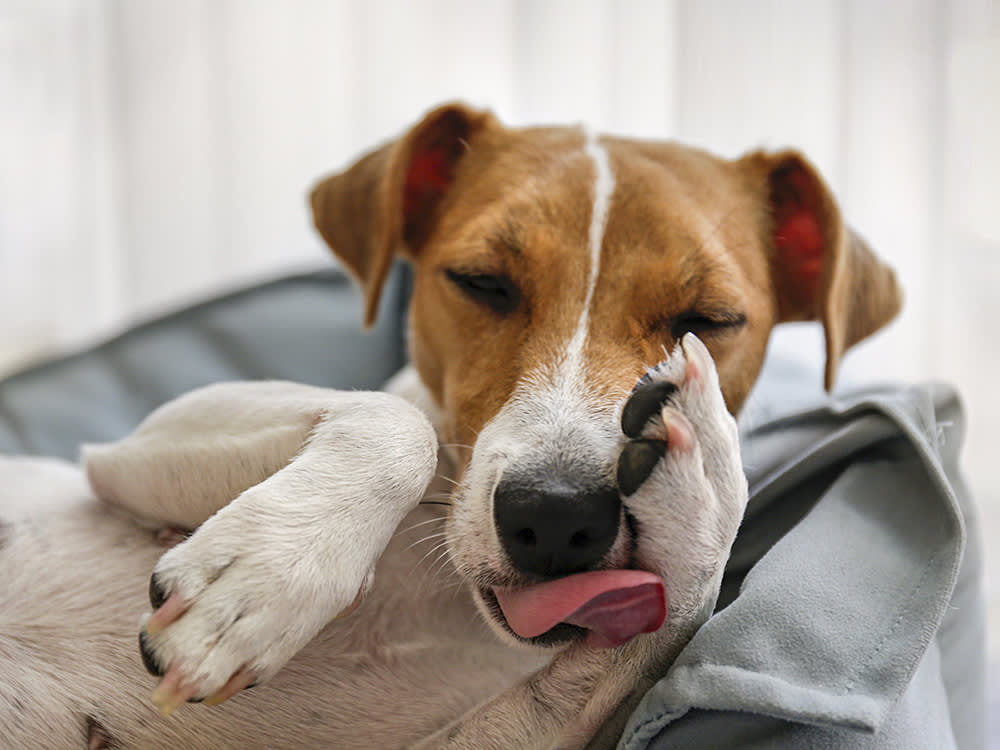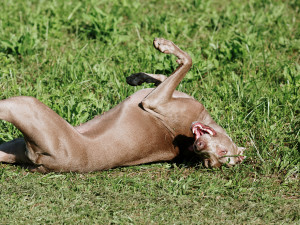Everything You Need to Know About Lick Granulomas
Acral lick dermatitis is a frustrating skin condition, but new treatments offer hope.
My first dog, Ouzel, a Lab mix, spent his last year worrying at a wart on his leg until it became a rough, raised, red patch — an acral lick granuloma. I tried bitter sprays, socks, steroid creams and an Elizabethan collar. I could not get him to stop. I was frustrated, he was obsessed. He died before I finished vet school and had learned about other treatment options.
What is a Lick Granuloma?
A lick granuloma, also known as acral lick dermatitis, is a stubborn skin problem that occurs when dogs excessively lick an area. The repeated licking typically on the lower leg leads to skin irritation and an open wound. Lick granulomas differ from hot spots because they are chronic and often persist despite treatment.
Save on the litter with color-changing tech that helps you better care for your cat.
What Causes Lick Granulomas?
There are many causes for lick granuloma inflammation, including referred pain from arthritis or disc issues, anxiety or boredom, food/flea/environmental allergies, wounds or lumps, and cancer. Whatever causes it, once a dog starts licking, it’s hard to halt. The wound gets thicker, wider, deeper, becomes ulcerated and infected. The hair does not come back, and the skin darkens. Lick granulomas are stubborn and complicated, and a combination of treatment therapies may be more successful. Often lick granulomas are controlled with treatment rather than cured.
Any breed can develop a lick granuloma, but Doberman Pinschers, Great Danes, Labrador Retrievers, Golden Retrievers and Irish Setters may have a predisposition to the condition. Lick granulomas occur most often in older, male, large-breed dogs, and treatment depends on what caused them in the first place.
Lick Granuloma Treatment Options
The treatment of lick granuloma will depend on your dog’s condition and the cause of the acral lick dermatitis. Deep infections often require six to eight weeks of oral antibiotics. Topical and oral steroids can help break the inflammatory cycle, and anti-anxiety medications can be tried.
Class IV Cold Laser Therapy
A newer treatment tool is also available to help manage granulomas, a Class IV laser, also called low level, or cold, laser therapy. Laser strength is described by class, and the stronger the wattage of the beam, the shorter the individual treatment. While class II-III are used by dermatologists for skin treatments, class IV’s light penetrates skin down into muscle, tendon, ligaments and bone.
A Class IV laser reduces inflammation, swelling, muscle spasms, stiffness and pain, and it can be used in veterinary offices to address wound care, post-op incisions, otitis, pancreatitis, arthritis, limb edema and soft-tissue injuries. The light, which is slightly warming, also stimulates acupuncture points, which is good for patients who cannot tolerate needles. Animals tend to find the treatment relaxing.
How Does Light Lead to Recovery?
On a cellular level, the laser enhances biological effects by increasing oxygen turnover in the tissues. Imagine a blood vessel as a moving sidewalk; as red blood cells cruise along under a spotlight (the laser), the beam heats the tissues and speeds up blood flow, which encourages oxygen uptake. With increased oxygen, more ATP (adenosine triphosphate) energy is made, which prompts healing. Present in every cell of the body, ATP is the body’s basic currency, energy used or stored in this nucleotide. When a group of atoms are cleaved off the side of ATP, energy is released to perform cellular activities.
Research conducted worldwide shows the widespread advantages of medical-grade lasers. Human studies found that lasers provide benefits for patients with fibromyalgia, tennis elbow, chronic neck pain, osteoarthritis, rheumatoid arthritis, traumatic neuropathic pain and compromised limb circulation. Wound healing and skin studies include positive effects for diabetic-ulcer healing, blood vessel growth, increased skin cell migration (fibroblasts), hair growth in canine non-inflammatory alopecia and survival of surgical skin flaps for wound coverage.
Laser treatment strength and duration are determined by the size of the area that needs to be addressed and whether the injury is acute or chronic, the wound is dermal or musculoskeletal, the fur is dark or light. After the veterinary team elects a treatment type, the machine calculates an appropriate and safe dose. Precautions are common sense: the light needs to be kept moving so that it doesn’t overheat skin, and it’s never used near a fetus or a tumor.
Laser Treatments for Lick Granulomas
For lick granulomas, the laser treatment focuses on small areas. In fact, the less the light is diluted, the more successful the treatments tend to be. For example, if your dog has arthritis in his knees, back and wrists, it’s best to work on them one at a time.
Laser protocols for lick granulomas recommend starting treatments two to three times a week for a few weeks, tapering to once a week, then to every two weeks as the wound shrinks over a month or so. The treatments have a cumulative effect, so it’s important to commit to the schedule.
With the addition of the Class IV laser, we now have a pocketful of treatment options for lick granulomas. Canine friends who spend their days and nights licking a limb might finally find the respite they need, which could improve our own sleep as well.
Home Treatment for Lick Granuloma
There are several ways you can soothe a lick granuloma at home. Some dogs are calmed by the snug swaddle of an anti-anxiety vest; relaxing treats with L-theanine, an amino acid that raises dopamine — and perhaps serotonin — levels; Bach’s Rescue Remedy; a pheromone collar or diffuser; and consistent, ample exercise.
Holistic modalities are also important. Chiropractic can help with disc-disease-related nerve pain, and an acupuncture approach I call “surrounding the dragon” encircles the wound with needles to reduce pain and inflammation. Finally, pet parents can elect surgery and CO2 laser, which uses highly concentrated light energy, to remove the sore.
Oh, and by the way, lasers can be found in printers, CD and DVD players, bar-code scanners and light shows, but these are too weak to use medically. Toy laser pointers, which some cats and dogs like to chase, are under 5 milliwatts and fall in the Class I-IIIa category. Never point any laser into the eye or at a reflective surface, like metal or glass. Laser-play can cause frustration in certain dogs, leading to obsessive-compulsive disorders.)






